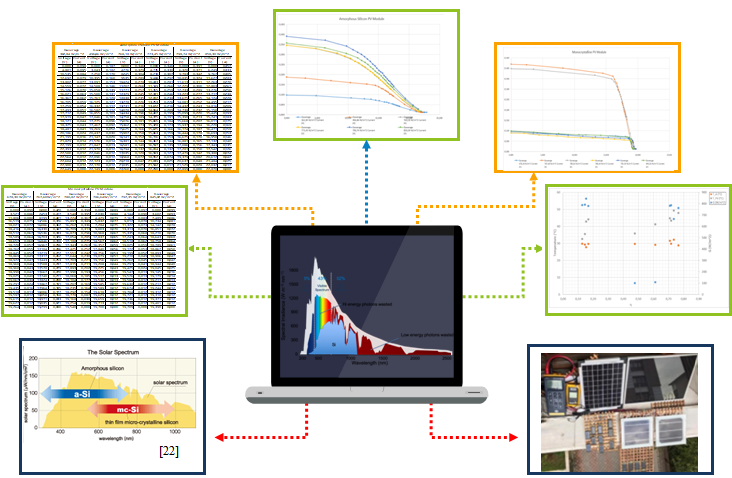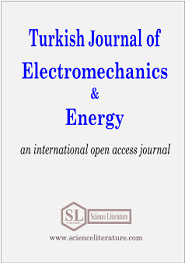
Amorphous and monocrystalline PV degradation investigations by the seaward PV200 solar PV tester
Abstract
This study, it is aimed to evaluate the degradation of two different types of photovoltaic (PV) technology; a 10 W Monocrystalline PV module and a 7 W Amorphous Silicon PV module. The electrical key parameters; open circuit voltage, short circuit current, maximum power point, current and voltage at maximum power point (MPP), fill factor of 10 W Monocrystalline PV module and MPP, current and voltage at MPP of 7 W Amorphous Silicon PV module. Five years later, key points of 10 W Monocrystalline and 7 W Amorphous Silicon PV modules are gathered via outdoor experiments conducted via the Solar Survey 200R and Seaward PV200 solar PV test devices. The solar radiation and temperature data is gathered via a 200R device, meanwhile, electric data result from the conversion of solar radiation via the PV module received via the Seaward PV200 Solar PV Test Device. The results illustrated that the open circuit voltage increased over time because of the degradation of the modules which also result in changes in almost all key parameters. For the amorphous panel, the study concluded with the voltage distortion rate at the MPP of 7.05% and the annual distortion rate at the MPP of the voltage at 1.41% between the 2016 and 2021 years. On the other hand, the decrease rate of the circuit voltage is -19.05; the annual deterioration rate was determined as -3.81%. For the monocrystalline panel, the voltage at the MPP is -16.67% and the annual voltage reduction rates from -3.33% are also the results of this study.
Full Text:
PDFReferences
Y. H. Kao, L. Kazmerski, K. G. Lynn, and A. Mascarenhas, Photovoltaics Characterization An Overview, Photovoltaics for the 21st Century. pp. 274-300, New Jersey: Electrochem. Soc., 2000, ISBN 1-56677p-233-8.
W. Krish, “Which Silicon Structure Makes the Most Effective Solar Cell?,” International Research Journal of Engineering Science, Technology and Innovation, 8(5), pp.1-7, 2022.
S. Hadi Susilo, A. Asrori, G. Gumono,“ Analysis of the efficiency of using the polycrystalline and amorphous PV module in the territory of Indonesia”, Journal of Applied Engineering Science, 20(1), 239-245, 2022.
D. C. Jordan., T. J. Silverman, J. H. Wohlgemuth, S. R. Kurtz, K. T. VanSant, “Photovoltaic failure and degradation modes,” Progress in Photovoltaics: Research and Applications, 25(4), 318–326, 2017.
M. Kumar, A. Kumar, “Performance assessment and degradation analysis of solar photovoltaic technologies: A review,” Renewable and Sustainable Energy Reviews, vol. 78, 554–587, March 2017.
A. Dhoke, R. Sharma, T. K. Saha, “PV module degradation analysis and impact on settings of overcurrent protection devices,” Solar Energy, vol. 160, pp. 360–367, December 2018.
IEC 60050-192:2015, "Standard,", Feb. 26, 2015. [Online]. Available: https://webstore.iec.ch/publication/21886 [Accessed: Oct. 16, 2020].
M. A. Munoz, M. C. Alonso-García, N. Vela, F. Chenlo, “Early degradation of silicon PV modules and guaranty conditions”. Solar Energy, 85(9), 2264–2274, 2011.
S. Kaplanis, E. Kaplani, “Energy performance and degradation over 20 years performance of BP c-Si PV modules,” Simulation Modelling Practice and Theory, 19(4), 1201–1211, 2011.
B. Nehme, N. K. M’Sirdi, T. Akiki, A. Naamane, “Contribution to the modelling of ageing effects in PV cells and modules,” Energy Procedia, vol. 62, 565–575, 2014.
K. R. Yedidi, “Failure and degradation modes of PV modules in a hot dry climate: Results after 16 years of field exposure”. M.Sc. Thesis, Arızona State Unıversıty, 2013.
D. Jordan, S. Kurtz, “3-Photovoltaic module stability and reliability. In The Performance of Photovoltaic (PV) Systems”, The Performance of Photovoltaic (PV) Systems Modelling, Measurement and Assessment, Woodhead Publishing, pp. 71–101, 2017.
A. Ndiaye, A. Charki, A. Kobi, C.M.F. Kébé, P.A. Ndiaye, V. Sambou, “Degradations of silicon photovoltaic modules: A literature review,” Solar Energy, vol. 96, pp. 140–151, 2013.
M. Köntges, S. Kurtz, C. E. Packard, U. Jahn, K. Berger, K. Kato, M. Van Iseghem, “Review of Failures of Photovoltaic Modules - IEA-PVPS T13-01:2014,” In IEA-Photovoltaic Power Systems Programme, IEA, 2014.
M. E. Şahin, H. I. Okumus, “The Design Steps of a Hybrid Renewable Energy System,” ICCESEN 2016, Antalya, Türkiye, 19 - 24 Ekim 2016.
M. E. Şahin, H. I. Okumus, “Modeling and Simulation of Solar Cell Module in Matlab/Simulink,” The Journal of Electrical, Electronics, Computer and Biomedical Engineering, 3(5), pp.17-25, 2013.
D. C. Jordan, S. R. Kurtz,. “Photovoltaic degradation rates-an analytical review,” Progress in Photovoltaics: Research and Applications, 21(1), pp. 12–29, 2013.
A. Dhoke, A. Mengede, “Degradation analysis of PV modules operating in the Australian environment,” 2017 Australasian Universities Power Engineering Conference (AUPEC), 2017-Novem, pp. 1–5, 2017.
Seaward, "PV200," 2018, [Online] Available: https://www.seaward.com/gb/support/download/300 [Accessed: Oct. 16, 2020].
Netes Documents, "Fluke," 2018, [Online] Available: https://www.netes.com.tr/netes/dosyalar/dosya/E808FA2AF4F661C 05048984E8F1798E8.pdf [Accessed: Oct. 16, 2020].
Seaward, "Solar Datalogger Software," 2018, [Online] Available: https://www.seaward.com/gb/support/download /371 [Accessed: Oct. 16, 2020].
Y.H. Kao, L. Kazmerski, K.G. Lynn, and A. Mascarenhas, Photovoltaics Characterization: An Overview Photovoltaics for the 21st Century. Electrochem. Soc., New Jersey, 2000.
D. Rekioua, T. Rekioua, Y. Soufi, “Control of a grid-connected photovoltaic system,” 2015 International Conference on Renewable Energy Research and Applications, ICRERA 2015, art. no. 7418634, pp. 1382-1387, 2015.
D. Rekioua, T. Rekioua, S. Bensmail, “Application of adaptive fuzzy logic controller to improve photovoltaic pumping system performances”, Turkish Journal of Electromechanics and Energy, 7(3), pp. 92-99, 2022.
N. Badi, S. Khasim, S. A. Al-Ghamdi, A. S. Alatawi, A. Ignatiev, “Accurate modelling and simulation of solar photovoltaic panels with Simulink- MATLAB’’ Journal of Computational Electronics, volume 20, pp. 974–983, 2021.
A. K. Srivastav et al., “Modelling and Simulation of Photovoltaic System Using Matlab/Simulink” Journal of Physics: Conf. Ser.: 1579 012024, 2020.
E. Cuce, “Thermodynamic analysis of the effectiveness of different types of PV modules for wet conditions,” M.Sc. Thesis Karadeniz Technical University, 2009.
E. Cuce, P. M. Cuce, T. Bali, “An experimental analysis of illumination intensity and temperature dependency of photovoltaic cell parameters,” Applied Energy, vol. 111, 374-382, 2013.
E. Cuce, T. Bali, “Variation of cell parameters of a p-Si PV cell with different solar irradiances and cell temperatures in humid climates,” Fourth International Exergy, Energy and Environment Symposium, 19-23 April 2009, Sharjah, United Arab Emirates.
I. B. Turna, Z. Er, “Performance monitoring of different types of photovoltaic cells”, Emerging Materials Research 2022 11(1), pp. 60-66, 2022.
Z. Er, Z. Rouabah, G. Kızılkan, A.T. Orken, “Standards and Testing Experiments for A Photovoltaic Module”, European Journal of Science and Technology (EJOSAT), 2017 Ejosat December Special Issue, pp. 12-15, 2017.
M. A. Omid, Ö. N. Cora, “State of the art review on the Cu(In, Ga)Se2 thin-film solar cells,” Turkish Journal of Electromechanics & Energy, 5(2), 2020.
URN: https://sloi.org/urn:sl:tjoee81278
Copyright (c) 2023 Turkish Journal of Electromechanics and Energy

This work is licensed under a Creative Commons Attribution-NonCommercial 4.0 International License.

 Indexed in:
Indexed in:
















